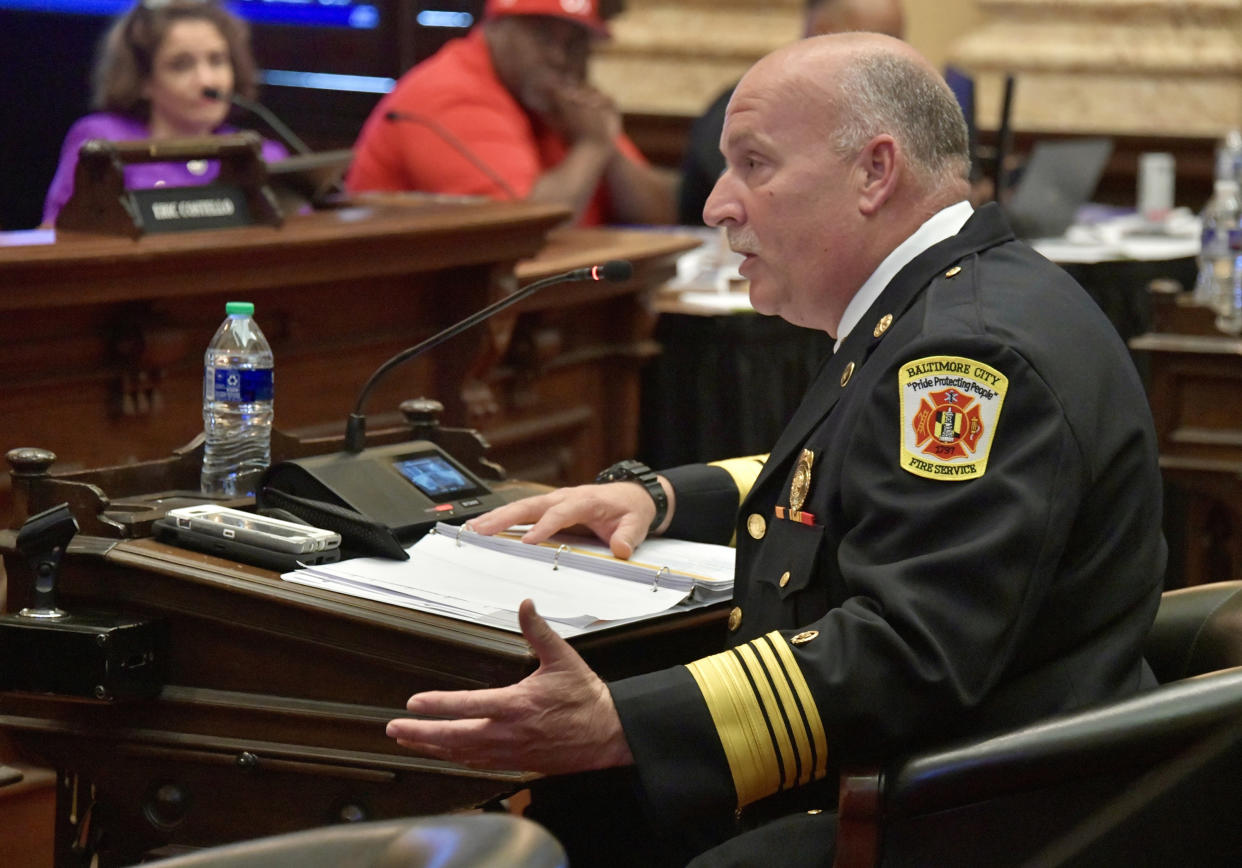In wake of deadly fire, Baltimore has funded only 1 of 4 requests related to safety

Baltimore has funded only one of four budget requests made to satisfy recommendations issued following a deadly fire on Stricker Street that killed three city firefighters in 2022, however it has made significant progress in tagging unsafe vacant buildings.
That update came Thursday during a budget hearing for the city’s Fire Department before the Baltimore City Council. Under questioning from the council, city fire and budget officials said Mayor Brandon Scott’s proposed spending plan for fiscal year 2025 includes funding for four fire safety officers introduced as part of the 2024 spending plan. However next year’s proposed budget still does not include money for other recommendations from the Stricker Street report, namely battalion command technicians to assist each of the city’s battalion chiefs.
The report, compiled by a panel of area fire officials in response to the fire, found the battalion chief on the scene at Stricker Street was overwhelmed by too many responsibilities, compromising the safety of city firefighters. The technicians were recommended to assist with coordinating personnel at fire scenes.
Council members asked fire officials Thursday to provide a written update on where the city stands with implementing the recommendations from the report.
The Stricker Street blaze claimed the lives of Lt. Paul Butrim, Lt. Kelsey Sadler and EMT/firefighter Kenny Lacayo in January 2022 after a vacant home they had entered to battle a fire partially collapsed on top of them. EMT John McMaster was also seriously injured. One of the deadliest in the city’s history and across the country that year, the fire prompted calls for reform (many of which were detailed in the report), resulted in the ouster of then-Fire Chief Niles Ford, and recently prompted a lawsuit from the families of several victims.
Fire Chief James Wallace, who succeeded Ford, told the council Thursday that his department has inspected more than 5,900 buildings and marked 648 as structurally unsafe since the restart of the Code X-ray program in October 2022, a separate recommendation made after the Stricker Street fire. The signs indicate to firefighters that they cannot safely enter a property to battle a fire inside.
The Fire Department originally began the Code X-ray program in 2010, marking buildings with red signs with white X’s to denote when a firefighter shouldn’t enter. The program informally ended around 2012 due to complaints that the signs were devaluing city neighborhoods.
The new signs dotting city buildings are red diamonds. City firefighters inspect neighborhoods across the city once a week looking for additional buildings to mark with the signs. Data from the inspections is uploaded to the Fire Department’s computer system which is then shared with Baltimore housing officials.
“That’s been an extraordinarily successful program,” Wallace told the council.
Council Vice President Sharon Green Middleton asked officials about the status of communication between the Fire Department and the Department of Community and Economic Development. Assistant Chief Dante Stewart said crews from both departments have been coordinating joint inspections of potentially hazardous buildings.
Wallace said the department is also working to build a database of incidents in which homeless residents are found inside buildings marked by Code X-ray signs.
“We find people in Code X buildings enough that it’s concerning,” Wallace said. “When we as a department take a posture that we’re not going to send our people into Code X-ray buildings, and then we find people in buildings, that’s the delicacy of this job. It’s extraordinarily difficult for our people to make it a go, no-go situation.”
Recommendations from the fire that have required significant staffing investments have been slower to materialize. Budget requests related to the Stricker Street fire made in 2024 included eight additional positions to assist the city fire marshal, additional staffing for the fire academy and 28 battalion command technicians — enough to assist all city battalion chiefs on all shifts.
City officials could not agree Thursday on whether the fire department’s 2025 budget request also included funding for the technicians.
Members of Engine 14 were the first to arrive at the Stricker Street fire in response to a 5:50 a.m. call. Sadler, who was promoted posthumously from acting lieutenant to lieutenant, was in command of the scene until a battalion chief arrived. She and her crew ran into the house, along with Butrim and two other members of Engine 36. They doused flames on the first floor before the collapse.
The report noted there were signs of a previous fire and structural instability when firefighters arrived, yet they used an “interior attack” despite those conditions, the report said.
The report found a battalion chief on the scene was overwhelmed by too many responsibilities. The chief, who was unnamed, told investigators he knew he was missing radio transmissions and was struggling to organize the response. The report found responding firefighters didn’t use “talk groups” to relieve congestion on the primary radio channel, causing the incident commander to “completely miss or mis-prioritize critical information.”
National fire standards recommend the use of battalion command technicians.
Councilwoman Phylicia Porter said Thursday she would like to see better coordination moving forward between fire officials tagging dangerous vacant buildings and the city’s demolition schedule.
“I’m thinking of it from a community perspective,” she said. “These buildings exist in a community for a longer period of time. They’re not being demolished. … They’re presenting public hazards for community members as well. That may be something we can push a little bit more.”

